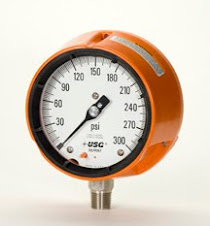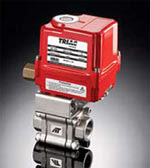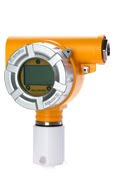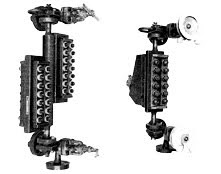Jerguson Solutions
Ammonia Refrigeration Level Measurement
Application Issue:
Major frozen food producers utilize ammonia and/or CO2 liquids for refrigeration and flash-freeze system management. Existing level indication on these systems is typically a long column with several small bulls-eye sight windows or, in some rare cases, an armored glass level gage, such as a Jerguson Series 20.
Ammonia Refrigeration Level Measurement
Application Issue:
Major frozen food producers utilize ammonia and/or CO2 liquids for refrigeration and flash-freeze system management. Existing level indication on these systems is typically a long column with several small bulls-eye sight windows or, in some rare cases, an armored glass level gage, such as a Jerguson Series 20.
There are two drawbacks to the column and bulls-eye window approach. First, the bulls-eye windows are spaced at about one-foot increments , making an accurate level verification virtually impossible. Second, due to the material of the glass used in these bulls-eye units, erosion can lead to catastrophic failures resulting in down time of the refrigeration system, lost production time on the freezer units, or, more importantly, possible harm to personnel.
Remote level monitoring of this system is typically accomplished through the use of a capacitance probe inserted into the top of the level column. Since oil can accumulate in this system, that oil can foul the capacitance transmitter and lead to a false level indication. If a capacitance transmitter needs to be replaced, the column must be isolated since the transmitter is in contact with the process.
An ammonia refrigeration system typically operates at temperatures in the range of -20°F to -80°F. While ammonia in the vessel may be very stable at a temperature of -20°F to -80°F, due to the vapor pressure of the system, temperature differences between the fluid in the vessel and gage column can cause flashing of ammonia in the gage column.
Jerguson® Solution
The new Jerguson FlashProof Magnicator II with a magnetostrictive transmitter addresses the concerns with traditional level controls in ammonia and/or CO2 refrigeration to provide reliable level indication and control. The FlashProof Magnicator II delivers the same reliable performance demanded of Jerguson’s Magnetic Level Gage, and the oversized 3” chamber with internal guides permits any entrained vapors due to boiling to harmlessly pass behind the float. The use of a Magnetic Level Gage in this application also allows easy level verification over the entire operating range, as opposed to guessing at a level by looking through portholes. The externally-mounted Magnetostrictive transmitter sends a continuous 4-20mA signal to the customer’s instrument panel for level control and is not affected by oils in the process.
Jerguson® Solution
The new Jerguson FlashProof Magnicator II with a magnetostrictive transmitter addresses the concerns with traditional level controls in ammonia and/or CO2 refrigeration to provide reliable level indication and control. The FlashProof Magnicator II delivers the same reliable performance demanded of Jerguson’s Magnetic Level Gage, and the oversized 3” chamber with internal guides permits any entrained vapors due to boiling to harmlessly pass behind the float. The use of a Magnetic Level Gage in this application also allows easy level verification over the entire operating range, as opposed to guessing at a level by looking through portholes. The externally-mounted Magnetostrictive transmitter sends a continuous 4-20mA signal to the customer’s instrument panel for level control and is not affected by oils in the process.
Due to the cryogenic temperatures in this application, the Non-Frost Extension option must be selected to facilitate insulation. (Field installation of the insulation eliminates the potential for damage during transit and installation.)
Contact Glen Doole at Peacock your Canadian Jerguson Representative for additional information!





















No comments:
Post a Comment